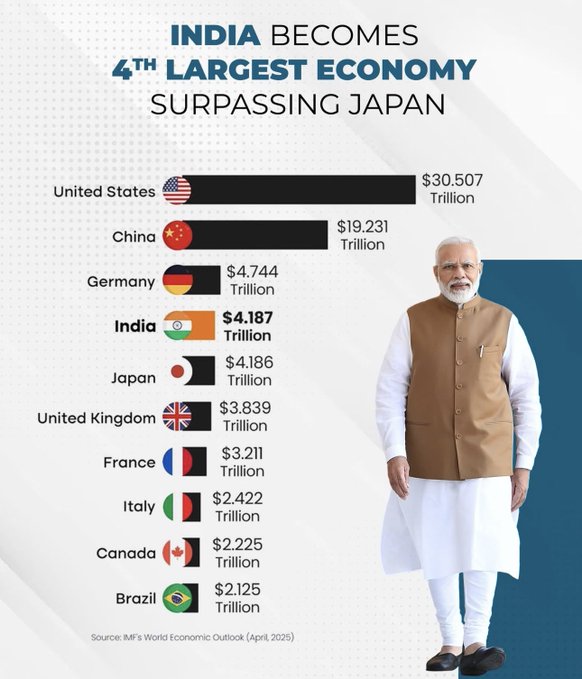
New Delhi: India has eclipsed Japan to become the world’s fourth-largest economy, reaching a GDP of $4 trillion, according to NITI Aayog CEO BVR Subrahmanyam, who cited International Monetary Fund (IMF) data. This achievement positions India behind only the United States, China, and Germany, with ambitions to overtake Germany within the next few years.
Speaking at a press conference following the 10th NITI Aayog Governing Council Meeting on Viksit Rajya for Viksit Bharat 2047 on May 25, 2025, Subrahmanyam announced, “We are the fourth largest economy as I speak. We are a USD 4 trillion economy as I speak, and this is not my data. This is IMF data. India today is larger than Japan.” He added, “It is only the US, China and Germany which are larger than India, and if we stick to what is being planned and what is being thought through, in 2.5-3 years, we will be the third largest economy.”
The IMF’s April 2025 World Economic Outlook projects India’s nominal GDP for fiscal year 2026 at $4,187.017 billion, just ahead of Japan’s $4,186.431 billion. India’s growth is expected to remain robust, with forecasts of 6.2% in 2025 and 6.3% in 2026, outpacing global averages of 2.8% and 3%, respectively. By 2028, India’s GDP is projected to hit $5,584.476 billion, potentially surpassing Germany’s $5,251.928 billion to claim the third spot.
Prime Minister Narendra Modi, who chaired the NITI Aayog meeting, emphasized collaborative progress toward a developed India. “Every Indian aspires for the country to be a Viksit Bharat. It is not the agenda of any party but the aspiration of 140 crore Indians. If all states work together towards this goal, then we will make stupendous progress. We should commit to developing every state, every city, and every village, and then Viksit Bharat will be achieved much before 2047,” he said.

Union Home Minister Amit Shah celebrated the milestone on X, posting, “A landmark moment for Bharat! Under PM Modi’s visionary leadership, India has become the 4th largest economy, surpassing Japan with a $4 trillion GDP. This is a proud milestone in our journey towards a Viksit Bharat by 2047!” Finance Minister Nirmala Sitharaman echoed this sentiment, stating, “India’s rise to the 4th largest economy reflects the strength of our reforms and global trust in our potential. The path to a $5 trillion economy is clear, and we are moving fast!”
Corporate leaders also expressed pride in India’s ascent. Anand Mahindra, Chairman of Mahindra Group, reflected on the significance of the achievement. “When I was in business school, the idea of India overtaking Japan in GDP felt like a distant, almost audacious dream. Today, that milestone is no longer theoretical — we’ve become the world’s fourth largest economy. It’s no small achievement. Japan has long been an economic colossus, with legendary productivity and resilience. That we’ve caught up is a testament to the ambition and ingenuity of millions of Indians — across sectors, generations, and geographies,” he posted on X. Mahindra also urged focus on per capita GDP, adding, “As we celebrate, we must stay dissatisfied. Because India’s next leap must be in per capita GDP, not just overtaking Germany… India needs sustained economic reforms — in governance, infrastructure, manufacturing, education, and capital access.”
Harsh Goenka, Chairman of RPG Enterprises, shared his enthusiasm on X, writing, “From the land of zero to the 4th largest economy in the world! India surpasses Japan with a GDP of $4.187 trillion. A billion dreams, one unstoppable journey. Jai Hind.”
Actor Amitabh Bachchan hailed the achievement, highlighting India’s rapid progress since independence. “T 5390(ii) -Jai Hind! India 4th largest economy in the World .. USA, China, Germany, India ..and 2.5 - 3 yrs will become 3rd largest. United States: With a GDP of $30.51 trillion. China: With a GDP of $19.23 trillion. Germany: With a GDP of $4.74 trillion. India: approx $ 4 trillion,” he tweeted. “What an incredible achievement for a country that became Independent just 75 yrs + ago ..How many other nations that got Independent 75 yrs back, have attained this kind of achievement,” he added.
Subrahmanyam credited India’s rise to domestic reforms and a favorable global environment. “India is at a takeoff stage where it can grow very rapidly, as has been done by many countries in the past... Given this, as well as the demographic dividend that India is actually blessed with for the next 20 to 25 years, that we can grow rapidly,” he said. Addressing concerns about potential U.S. tariffs under President Donald Trump, who suggested iPhones sold in the U.S. should be manufactured domestically, Subrahmanyam noted, “What the tariff will be, is uncertain. Given the dynamics, we will be a cheap place to manufacture.”
The government is also gearing up for a second round of asset monetization, set to be unveiled in August 2025, to sustain economic momentum. However, opposition voices, like Congress leader Jairam Ramesh, cautioned that GDP growth alone doesn’t address ground-level challenges. “While the $4 trillion mark is notable, it masks stark inequalities. Real progress lies in uplifting the millions still struggling with basic needs,” he posted on X.
As India strengthens its role in global supply chains through initiatives like ‘Make in India,’ the focus remains on balancing rapid growth with inclusive development to achieve its $5 trillion economy goal by 2028.












